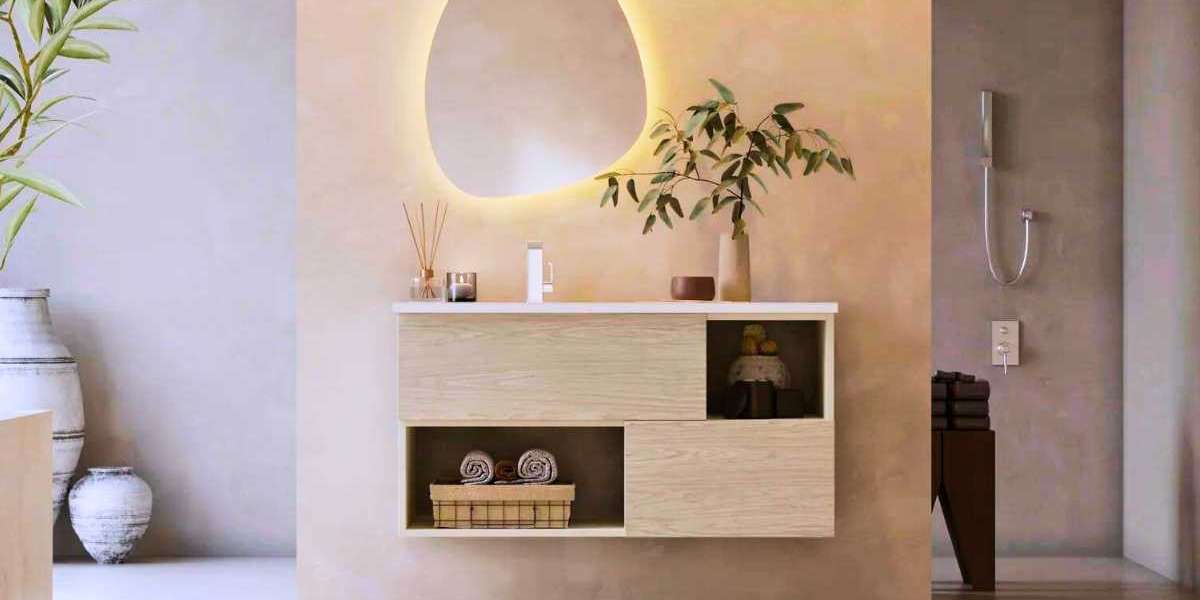Why Choose a Floating Bathroom Vanity with Sink?
Floating bathroom vanities with sinks are a popular choice for modern bathrooms. Their sleek, wall-mounted design offers a contemporary look while maximizing floor space, making them ideal for large and small bathrooms. These vanities not only enhance the aesthetic appeal of your bathroom but also provide practical benefits such as easier cleaning and flexible storage options.
Assessing Your Bathroom Space
Before selecting a floating vanity, assessing your bathroom space is essential. Start by measuring the dimensions of your bathroom, noting the width, depth, and height available for the vanity. Consider the layout and location of existing plumbing, as this will impact your installation options. For smaller bathrooms, floating vanities can make the space feel larger by exposing more floor area. A well-chosen floating vanity can serve as a stylish focal point in larger bathrooms.
Selecting the Right Size and Style
The size and style of your floating vanity should complement your bathroom’s overall design. Standard sizes for floating bathroom vanity with sink range from 24 to 72 inches, so you can find one that fits your space perfectly. When it comes to style, there are numerous options to consider. Minimalist designs with clean lines and simple finishes are ideal for modern bathrooms. If you prefer a rustic look, consider a vanity with a natural wood finish. For a more luxurious feel, opt for a vanity with intricate details and a high-gloss finish.
Matching the vanity style to your bathroom décor ensures a cohesive look. For instance, a sleek, black vanity works well in a contemporary bathroom, while a distressed wood vanity fits perfectly in a farmhouse-style bathroom.
Material Matters: Choosing the Best Materials
Choosing the right material for your floating vanity is crucial for durability and aesthetics. Common materials include:
- Wood: Offers a natural, warm look but requires sealing to protect against moisture.
- MDF (Medium-Density Fiberboard): Affordable and available in various finishes, but less durable than solid wood.
- Glass: Provides a modern, sleek appearance but can be fragile and prone to fingerprints.
- Metal: Durable and contemporary but can be cold to the touch and prone to water spots.
Each material has its pros and cons. For instance, wood requires regular maintenance to prevent water damage, while metal is durable but may require frequent cleaning to maintain its appearance. Consider your lifestyle and maintenance preferences when selecting the material.
Sink Options and Configurations
Floating vanities come with various sink options and configurations. Integrated sinks offer a seamless look and are easier to clean since there are no gaps between the sink and the countertop. Separate sinks allow for more customization in terms of shape and material.
Common sink types include:
- Undermount: Installed below the countertop for a clean, streamlined look.
- Vessel: Sits on the countertop, making a bold design statement.
- Drop-in: Mounted into the countertop, with the sink rim resting on top.
- Wall-mounted: Attached directly to the wall, freeing up counter space.
Choosing the right sink shape and size depends on your needs and bathroom design. A round vessel sink can add elegance, while an undermount sink provides a sleek, functional appearance.
Storage Solutions: Balancing Style and Function
Balancing style and function is key when selecting a floating vanity. Built-in storage options like drawers, shelves, and cabinets help keep your bathroom organized. Look for vanities with customizable storage solutions, such as pull-out trays, hidden compartments, and adjustable shelves, to fit your needs.
Maximizing storage space is crucial, especially in smaller bathrooms. Consider vanities with deep drawers or dual-level shelving to efficiently store toiletries, towels, and other essentials. Keeping your bathroom organized enhances functionality and maintains a clean, clutter-free look.
Finish and Color Choices
The finish and color of your floating vanity significantly impact the overall bathroom design. Popular finishes include matte, glossy, and textured. Matte finishes offer a contemporary, understated look, while glossy finishes add a touch of glamour. Textured finishes, such as wood grain or concrete, can add depth and interest to your vanity.
When choosing a color, consider the overall color scheme of your bathroom. Neutral colors like white, black, and grey are versatile and timeless, while bold colors like navy, emerald green, or even vibrant hues can make a statement. Trends in vanity finishes and colors for 2024 include natural wood tones, deep blues, and sleek black finishes.
Quality and Durability Considerations
Assessing the quality and durability of a floating vanity is essential to ensure it withstands daily use. Look for vanities made from high-quality materials and constructed with solid craftsmanship. Features such as soft-close drawers and doors, sturdy hardware, and durable finishes indicate good quality.
Checking for warranties and guarantees can also provide peace of mind. A warranty ensures that any defects or issues will be addressed, protecting your investment in the long run.
Installation Tips and Professional Help
Installing a floating vanity can be a DIY project but requires careful planning and precise execution. Here are some installation tips:
- Measure and Mark: Determine the desired height and location, and mark the wall accordingly.
- Find Studs: Use a stud finder to locate wall studs, ensuring the vanity is anchored.
- Install the Bracket: Attach the mounting bracket to the wall, ensuring it is level and securely fastened.
- Mount the Vanity: Lift the vanity onto the bracket and secure it.
- Connect Plumbing: Attach the sink and connect the plumbing fixtures.
While DIY installation is possible, hiring a professional can ensure the job is done correctly, especially if you’re unfamiliar with plumbing or wall-mounting procedures.
Budgeting and Finding the Best Deals
Setting a budget for your Emoya Home floating vanity purchase helps narrow down your options. Prices can vary widely based on materials, size, and brand. To find high-quality, affordable vanities, consider shopping during sales events like Black Friday or end-of-season sales.
Both online and in-store options offer advantages. Online shopping provides a wide selection and customer reviews, while in-store shopping lets you see and feel the product before purchasing. Comparing prices and reading reviews can help you make an informed decision.
Conclusion
Choosing the perfect floating bathroom vanity with a sink involves careful consideration of size, style, materials, storage options, and budget. By assessing your bathroom space, selecting the right sink configuration, and focusing on quality and durability, you can find a vanity that enhances your bathroom's functionality and aesthetic. With the right choices, your floating vanity will be a stylish centerpiece that transforms your bathroom into a modern, elegant space.








